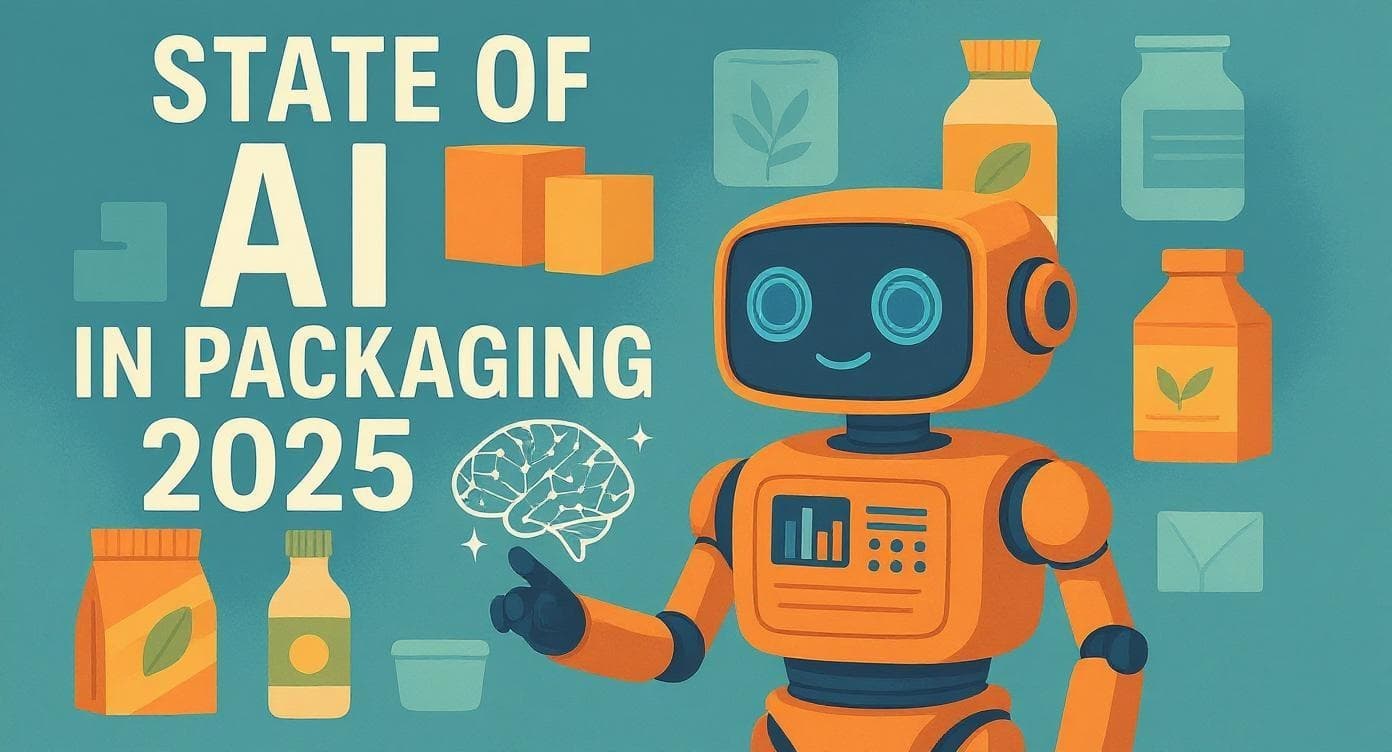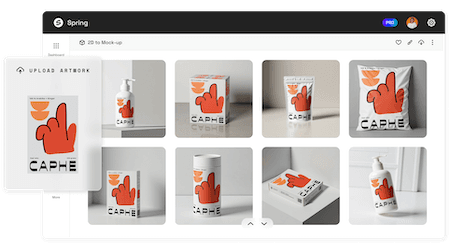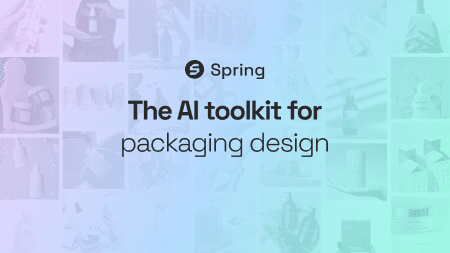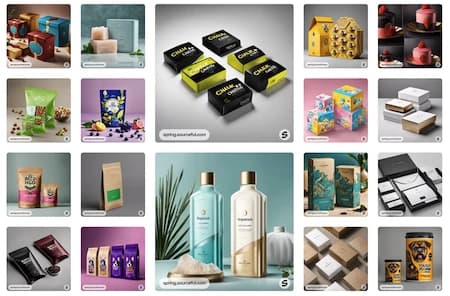Blog PostMaterials for packaging: a complete guide
- Sustainability
- Innovation
- Materials
- Design
Rachel LawtonMay 2, 2023 - 8 min read
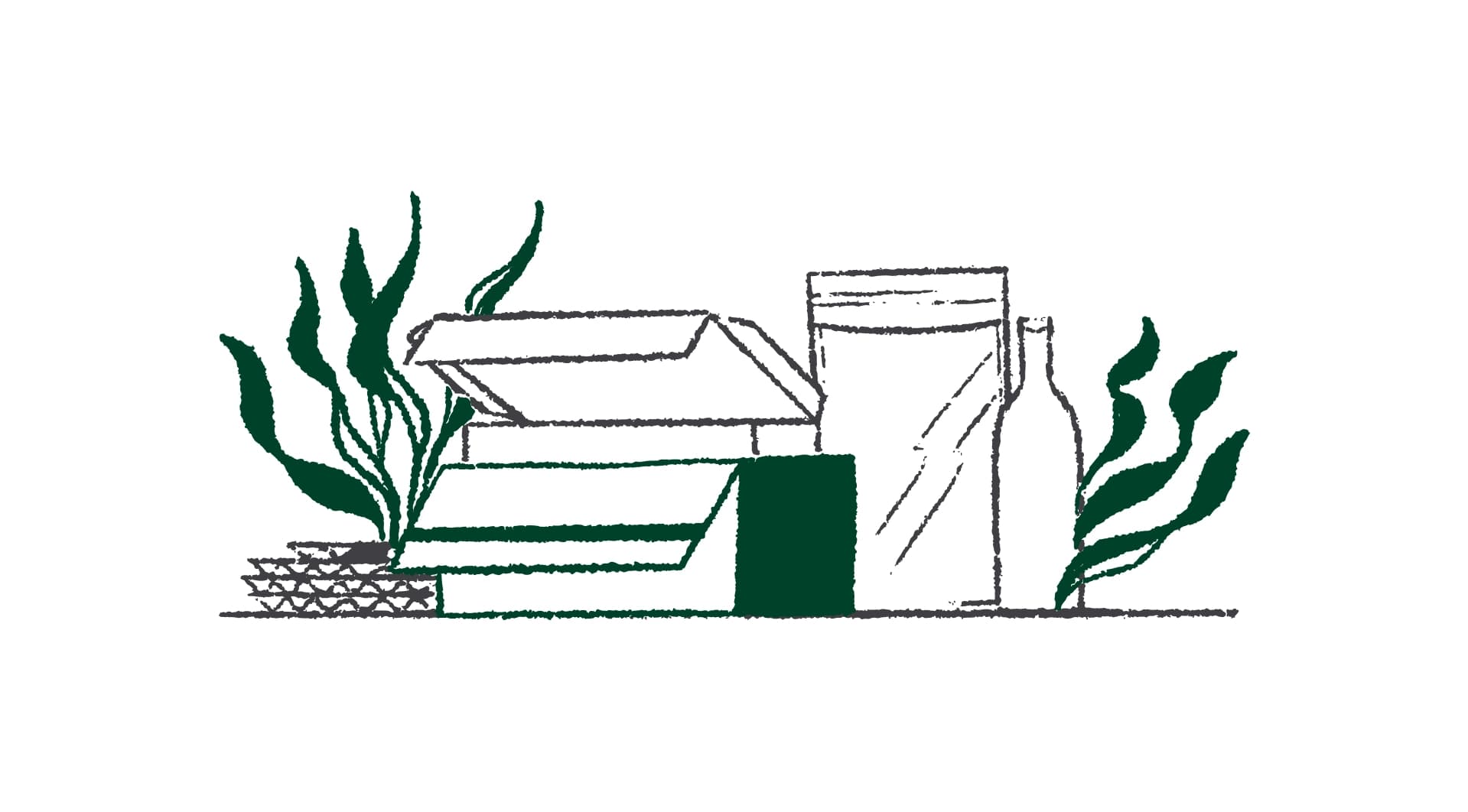
From bread wrapping to cardboard shipping boxes, it’s hard to escape some form of packaging in our day-to-day lives. But have you ever considered just how many packaging materials there are or why some are better than others?
Below we discuss the properties of the most common (and some not-yet-so-common) packaging materials and break them down into four categories: primary, secondary, tertiary and ancillary packaging.
Packaging materials
- Primary packaging materials
- Glass
- Metal
- Paper and card
- Seaweed
- Plastic
- Bioplastics
- Secondary packaging materials
- Paper and card
- Plastic
- Tertiary packaging materials
- Wood
- Corrugated cardboard
- Plastic
- Ancillary packaging materials
- Paper and card
- Fabric
- Mycelium
- Plastic
Primary Packaging
Primary packaging is designed to contain and preserve contents. It’s in direct contact with the product and is also known as “consumer packaging.” For example, that sealed pouch you can buy your coffee in? That’s primary packaging.
Primary packaging isn’t purely about function. It also acts as a source of information for the customer, including branding and product information.
Primary packaging materials include:
- Glass
- Metal
- Paper and card
- Seaweed
- Plastic
Glass: best for product visibility
When you hear the sound of glass clinking, what do you think of? Maybe a celebratory toast? Or a luxury item? That’s not accidental. Thanks to its glossiness and weight, glass packaging signals “high-quality” to the customer. And for that reason, it’s especially popular in the cosmetics and food and drink industries.
But glass is much more than just fancy packaging. Due to its inert qualities, it doesn’t affect the taste, smell or quality of its contents. It’s easy to sterilise and impermeable, keeping products safe and fresh. And as it’s transparent, users can see what’s inside. Pretty helpful for buying and checking whether products are still safe to use (because no one wants mouldy food).
As long as it’s used multiple times, glass is considered a more sustainable alternative to plastic. This is because it’s infinitely recyclable, without losing any of its quality. But one disadvantage of glass is that it often needs extra materials, such as silicone lids and seals, so that it can be closed securely.
Glass is commonly used in bottles, jars and ampoules. It’s easy to label and can be embossed and etched upon to generate brand awareness.
Benefits of glass
- Inert
- Reusable
- Infinitely recyclable
Cons of glass
- Fragile
- Production is energy-intensive
- Requires secondary packaging
- Heavy (increased transport emissions and costs)
Metal: best for extending shelf life
Most of us will be familiar with that tin of beans that’s been in the cupboard for years and is still fine to use. That’s because metal packaging is an excellent preserver. It seals products, keeps out external elements and maintains freshness.
Aluminium and steel are the most common kinds, often found in the form of foils and cans. But it’s not just the food and drink industry that sees the benefits of metal packaging. Others, like cosmetics, are seeking more sustainable alternatives to plastic and are increasingly switching to metal packaging. And this is not just because of metal’s ability to preserve products. Like glass, metal suggests a higher quality product compared to plastic packaging, which can be appealing to customers.
Some examples of metal packaging are drinks cans, food tins, aluminium wrapping and cosmetics packaging like lip balm tins.
Benefits of metal
- Easily shaped
- Strong and durable
- Infinitely recyclable
Cons of metal
- Can be costly
- Corrosion can be an issue
- Sometimes heavy (increased transport emissions and costs)
Paper and card: best for dry goods and lightweight products
Both paper and card are widely recyclable, often collected at kerbsides and easily recycled into new products. Combine this with responsible sourcing and the use of natural inks and paper and card are some of the most sustainable packaging materials available.
Paper and card are a popular choice for items that are dry or that don’t need airtight seals. Examples include paper bags, egg cartons and wrapping for cosmetic products like soap bars.
Benefits of paper and card
- Renewable
- Recyclable
- Lightweight
- Cost-effective
- Use recycled content
Cons of paper and card
- Not airtight
- Not waterproof
- Not as strong or durable as metal or glass
Seaweed: a potential replacement for plastic films
Can you imagine popping a seaweed “bubble” in your mouth and biting down to get a burst of whatever’s inside? Because that’s now a reality. Seaweed is being used to create food and drink sachets. It’s a fast-growing, renewable resource that doesn’t require land, freshwater or fertilisers to grow. So, it offers a more sustainable alternative to plastic films.
Because it can be consumed along with its contents, seaweed packaging leaves no waste. And, since it’s edible, it’s non-toxic. Meanwhile, if used to package non-food products, like cosmetics, it can still be disposed of with other organic waste. It will then break down naturally without leaving harmful substances behind.
Benefits of seaweed
- Renewable
- Breaks down in nature
- Typically no harmful chemicals
- Can be transparent (allowing for product visibility)
Cons of seaweed
- Still in the development stage
- May condense on the inside, creating mould
Plastic
Plastic poses a severe threat to the environment. The world produces 400 million tonnes of plastic a year, of which 76% ends up in landfills or released into the environment. It takes hundreds of years to break down and releases harmful chemicals and emissions as it does. In fact, every year, plastic packaging contributes 1.8 billion tonnes of carbon emissions to our planet.
What’s more, when plastic does break down, microplastics stay in the environment. These small plastic fragments work their way onto land and into rivers and oceans, where they can be ingested by animals. Microplastics have even been found in living humans, where they can damage cells.
The variety of packaging alternatives to plastic is increasing. Meanwhile, governments around the world are cracking down on plastic use with incentives like the Plastic Packaging Tax. So, before opting for plastic, check what else is out there so that you can avoid contributing to the plastic waste crisis. Otherwise, use plastic that contains recycled content.
Below, we dig into the two main forms of plastic and consider more sustainable alternatives that you can use to reduce your dependence on them.
Soft plastic
Soft or flexible plastic packaging includes films, bags, wrapping and void fillers like bubble wrap.
In 2020, soft plastic made up 22% of UK consumer packaging, yet only 8% of it was recycled. If you’re unable to find an alternative, replace it with more sustainable packaging, such as a recycled plastic mailer bag.
Benefits of soft plastic (primary packaging material)
- Cheap
- Easily shaped
- Lightweight and flexible
- Recyclable (in some cases)
Cons of soft plastic (primary packaging material)
- Difficult to recycle
- High carbon footprint
- Not puncture resistant
- Takes hundreds of years to decompose
- Releases harmful chemicals and microplastics
Rigid plastic
On the other hand, rigid plastic is used for heavier or more fragile products. They’re used in industries including food and beverages, cosmetics, medicine and electronics.
But there are many more sustainable alternatives to rigid plastic, such as cartonboard, metal containers, glass and bamboo packaging. And let’s not forget that 72% of customers consider sustainability in their purchasing decisions. So, choosing more sustainable materials is better for the planet and your business.
Benefits of rigid plastic
- Cheap
- Lightweight
- Easily shaped
- Strong and durable
Cons of rigid plastic
- High carbon footprint
- Some types are not easily recyclable
- Takes hundreds of years to decompose
- Releases harmful chemicals and microplastics
Bioplastics
You might hear the term “bioplastics” and think these are a more sustainable alternative to plastic. In reality, it’s more complicated than that.
Bioplastics are made from renewable materials such as sugarcane and corn. Whilst these raw materials are bio-based, they don’t necessarily help to solve the plastic waste crisis.
This is because the controlled industrial infrastructure that bioplastics need to decompose isn’t widely available. So, bioplastics often still end up in landfills and waterways, where the lack of oxygen stops them from breaking down. They can then persist in the environment for a long time, releasing harmful greenhouse gases, like methane.
Bioplastics are currently used for food packaging, cutlery, bags and films. If possible, we always recommend using more sustainable alternatives, such as bamboo cutlery.
Benefits of bioplastics
- Use natural materials
- Similar properties to plastics
- Reduces reliance on fossil-fuel materials
Cons of bioplastics
- Need to be industrially processed
- Not as cheap as traditional plastic
- Sometimes have a higher footprint than fossil plastics
Secondary packaging
Unlike primary packaging, secondary packaging isn’t in direct contact with the product. It’s designed to group items together for better stock organisation. Secondly, it protects primary packaging during transportation. For example, think of a box of cereal. The cardboard box that contains the cereal bag is the secondary packaging. That box contains the primary packaging (bag) that directly holds the product (cereal).
Secondary packaging can also reduce tampering with the primary packaging. And (think of that cereal box again) it can be used to display branding and can influence customer perception and purchasing.
Secondary packaging materials include:
- Paper and card
- Plastic
Paper and card: good for branding and product information
The secondary packaging market is being driven by the demand for more sustainable materials, such as paper and card.
As secondary packaging, paper and card are often used to create boxes, bags, and wraps. They can be cut and folded into hundreds of configurations to suit both the product and the brand image. Paper and card are easy to print on. So, they’re good materials for providing product information and branding which attracts customers.
Common examples of paper and card as secondary packaging include carton boxes, corrugated card boxes and sleeves. They can also act as more sustainable alternatives to traditional materials — think swapping out the plastic rings on packs of drinks cans for cardboard ones.
Benefits of paper and card
- Renewable
- Recyclable
- Lightweight
- Customisable
- Cost-effective
Cons of paper and card
- Not be suitable for fragile items
- Not be as durable as glass or metal
- Limited protection against moisture and air
Plastic
Plastic is widely used in primary, secondary, tertiary and ancillary products. As a secondary packaging material, it can make up stretch wrapping, shrink wrapping and blister packaging. As mentioned earlier, plastic packaging poses serious threats to environmental and human health. So, we always advise looking at alternatives or recycled plastic products over virgin products.
Tertiary packaging
Tertiary packaging protects and transports secondary packaging and multiple units of products. Unlike primary packaging, it isn’t designed for the end user. In fact, it’s usually removed at a distribution centre, before the products reach their retail destination.
Tertiary packaging you’d probably recognise includes pallets and shipping cartons. These allow products to be efficiently moved through the supply chain.
Primary packaging materials include:
- Wood
- Corrugated cardboard
- Plastic
Wood: best for heavy goods
Wood has been used for centuries to transport goods easily and securely. Wooden crates and pallets are the most common packaging examples. These can be custom-sized to fit the needs of the product or shipping method being used. And thanks to its strong, durable nature, wooden packaging can also be stacked to maximise shipping efficiency.
When sourced responsibly, wood-based packaging can be a more sustainable alternative to materials like plastic as the wood comes from renewable, natural sources.
Benefits of wooden crates
- Durable
- Reusable
- Excellent protection
- Easily transported with machinery
Cons of wooden crates
- Heavy
- Inconvenient to store
- Not be suitable for fragile items
- Need maintenance to ensure longevity
Corrugated cardboard: best for lightweight goods
When you think of shipping goods, chances are you’ll think of the iconic corrugated cardboard box. As a packaging material, corrugated cardboard has stood the test of time thanks to its lightweight yet durable qualities.
Corrugated sheets are made from two kraft liners that sandwich a corrugated board, called the ‘fluting’. You can choose your fluting thickness, which gives you control over the level of protection your packaging offers. What’s more, corrugated card can be cut to any size, creating a bespoke packaging product.
In boxes, corrugated card is used to ship multiple units of secondary packaging and its contents. The boxes are easy to stack and can be labelled with important shipping information. Using corrugated card as a packaging material streamlines the transportation process.
Cardboard is a renewable material that can be sourced from responsibly managed forests. As it can be easily customised to fit the product, it can also help reduce material waste and make shipping more efficient.
Benefits of corrugated cardboard
- Durable
- Recyclable
- Lightweight
- Customisable
- Can be made with recycled material
Cons of corrugated cardboard
- Not waterproof
- Not suitable for heavy items
- May require additional materials to protect fragile items
Plastic
As a tertiary packaging material, plastic can be used in stretch wrapping, shrink wrapping and intermediate bulk containers. And whilst products like intermediate bulk containers can be reused many times, it's still recommended that you explore alternatives or recycled plastic products. That’s because virgin ones have a higher carbon footprint, making them less sustainable.
Ancillary packaging
Ancillary packaging’s job is to support or enhance primary, secondary, or tertiary packaging. It offers extra information, protection or convenience in the form of labels, sleeves, stickers, tapes and inserts. It can also create a more impressive experience for the customer.
Ancillary packaging can be made from:
- Paper and card
- Fabric
- Mycelium
- Polystyrene and plastics
Paper and card: best for labels, tags, gummed tape and leaflets
How many times have you sifted through a clothes rack, flipping over labels until you find your size? Those labels are a prime example of ancillary packaging. And in this category, paper and card are the go-to materials when it comes to branding, informational labels and promotional materials. This is because they’re cost-effective, widely available and easily customised.
Another type of paper ancillary packaging is gummed tape, a more sustainable alternative to plastic packaging tape. And not forgetting the familiar paper leaflet, which is a cheap and easy way to communicate information to your customers.
Benefits of paper and card
- Recyclable
- Customisable
- Cost-effective
- Great for branding
- Can be responsibly sourced
- Ideal for product information
Cons of paper and card
- Limited protection against moisture and air
Fabric: best for enhancing presentation
Picture that quintessential Christmas present. Does it have a bow? That mental image exists because whether as a bag, pouch, wrap or ribbon, fabric can add an extra special touch. Fabric is often used to offer additional protection to the primary or secondary packaging, as well as enhance its presentation.
When choosing fabric packaging, natural fibres like organic cotton are a much more sustainable alternative to synthetic fabrics, such as nylon and polyester. And in the spirit of sustainability, fabric packaging can also be reused and repurposed. In fact, the Japanese practice of furoshiki sees gift-givers wrapping presents in fabric. It can be kept to wrap another gift, serve as a placemat, used as a bandana and many more.
Examples of fabric packaging include small gift bags, velvet or suede pouches for luxury products, canvas or cotton wraps and jute bags.
Benefits of fabric
- Reusable
- Recyclable
- Can be made from natural fibres
- Can be customised for branding
Cons of fabric
- More expensive than paper packaging
- Limited protection against moisture and air
- Reuse requires additional cleaning or maintenance
Mycelium: a potential replacement for polystyrene
Mycelium is gaining in popularity as a more sustainable solution to protective packaging, like polystyrene. It’s made from the root network of mushrooms and needs little light and water to grow. It can also feed off agricultural scraps which would otherwise be wasted, so it’s pretty resource-efficient.
Mycelium packaging can be grown in just a few days and breaks down naturally in a matter of weeks. What’s more, it can be shaped around any form, allowing you to create bespoke packaging for any product. Like Electronics retailer Dell, which switched to mycelium to protect delicate electrical equipment from damage during transit.
The thing is, mycelium as a packaging material is relatively new. So, no one really knows how sustainable it will be in the long term. What we do know is that it seems to be a good replacement for polystyrene, which is a synthetic material. And let’s not forget that extracting and disposing of polystyrene negatively affects soil and water systems. So, if you used mycelium instead of polystyrene, you’d likely reduce your environmental impact.
The known drawbacks are that because mycelium does break down in nature, it will release greenhouse gases in the process. And if it’s not processed in the right facilities, this will increase its carbon footprint significantly.
Benefits of mycelium
- Renewable
- Lightweight
- Easily moulded
- Breaks down in nature
- Excellent shock absorption
Cons of mycelium
- Limited availability
- Disposal requires a specialised facility
- Emissions when breaking down
Plastics and polystyrene as ancillary packaging
Plastic is often used to create tape, tags and labels. This secures packaging and can provide information to the user. Polystyrene, a petroleum-derived plastic product, is used to fill voids and cushion delicate products during transit. Other examples of plastic in ancillary packaging include bubble wrap, plastic bags, plastic windows and wrapping.
At Sourceful, we help brands switch from using plastic packaging as we know there’s a more sustainable alternative for almost every need. And actually, it’s never been easier to ditch this harmful material and reduce your business’s environmental footprint.
If you can’t do without the properties of plastic, use recycled plastic packaging, like our recycled mailer bag. It’s better and more sustainable to give plastic a second life than to create new plastic with virgin materials.
More sustainable packaging with Sourceful
Here at Sourceful, we’re passionate about making packaging more sustainable. That’s why most of our packaging is made with paper and card. These are renewable materials that, in our case, come from responsibly managed forests certified by the Forest Stewardship Council. We also use recycled material wherever possible, as with our book mailer and recycled poly mailer.
What’s more, we help brands become more sustainable whilst avoiding the pitfalls of accidental greenwashing. To do this, we only work with vetted suppliers who adhere to strict EU and UK environmental standards. We also created our Impact Engine, which allows you to see your carbon footprint in real time as you create your packaging online. This brings a new level of transparency to packaging design, helping you know exactly what’s in your packaging and pass on accurate information to your customers.
Learn more: How to Avoid Greenwashing in 8 Steps
4 factors to consider when choosing a packaging material
With such a wide range of options, choosing a packaging material that suits your product’s needs can seem daunting. And as extended producer responsibilities come into play, you might also be thinking about making your packaging more sustainable.
So, when considering your packaging materials, think about the following four questions:
1. What level of protection does your product need?
Your product’s characteristics are the biggest indicators as to which packaging material to choose.
For example, if you’re shipping a soft and bendable product, like a t-shirt, you won’t be worried about it cracking during transit. But, you might want to make sure that it is protected against moisture. So, in this case, a recycled mailer bag would probably be more suitable than a rigid mailer box.
Once you figure out your product’s properties and how it will cope when handled, you’ll have a good idea of which material is right for you.
2. What are the costs?
When juggling business costs, it can be tempting to choose the cheapest packaging material for your product. But reduced initial costs don’t always mean long-term savings.
For example, plastic is so widely used because it’s cheap to make. But governments are cracking down on waste with initiatives such as the Plastic Packaging Tax. These will see businesses facing fines if their use of plastic breaches regulations. So what’s cheap in the short term might end up costing you more over time.
And that’s not all. More and more, customers are seeking out brands with sustainable values. In fact, 61% of customers are prepared to switch brands after just one negative experience. So showing that you understand what matters to them is more important than ever. Switching to more sustainable materials doesn’t have to be costly. But even if you did face some up front costs, maintaining and growing your customer base can benefit your business in the long run.
Learn more: What's the cost of more sustainable packaging in 2023?
3. What more sustainable alternatives exist?
When choosing a packaging material, always investigate whether there’s a more sustainable option.
For example, you might be using cardboard boxes to ship your product, but are these sourced from responsibly managed forests? Simply upgrading your paper products to FSC-certified products means you’re sourcing your materials in a more sustainable way.
Or, if you need a waterproof mailer bag but you don’t want to increase plastic waste, you can opt for a recycled poly mailer instead.
Packaging will always have a footprint, so you can reduce it by using materials already in circulation, instead of new ones.
Switch to more sustainable packaging with Sourceful
Whether at the primary, secondary, tertiary or ancillary level, packaging serves to protect the product so that it can reach the customer as intended. And from individual food and cosmetics products to large bulk shipments, there’s a wide range of packaging materials available. Some, like metal and glass, can be associated with quality and luxury. Others, like plastic, are convenient yet environmentally problematic.
But deciding which material is right for you doesn’t have to be a challenge. At Sourceful, we have a wide range of more sustainable, functional packaging materials that cater for many different products and industries.
From our FSC-certified paper products to our certified recycled plastic ones, you can see exactly what goes into your packaging with detailed information on our product pages. And, when you design your packaging online, our live carbon data lets you know the impact of each material, taking you one step closer towards your sustainability goals.
To figure out your packaging needs and switch to more sustainable materials, get in touch with us today.



